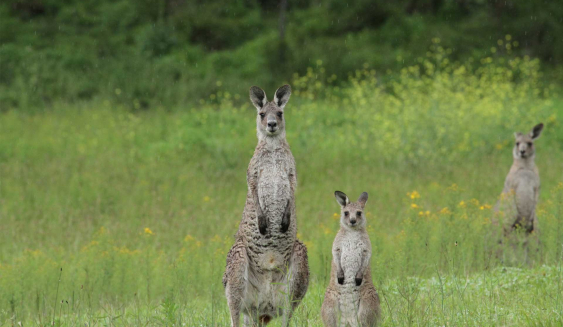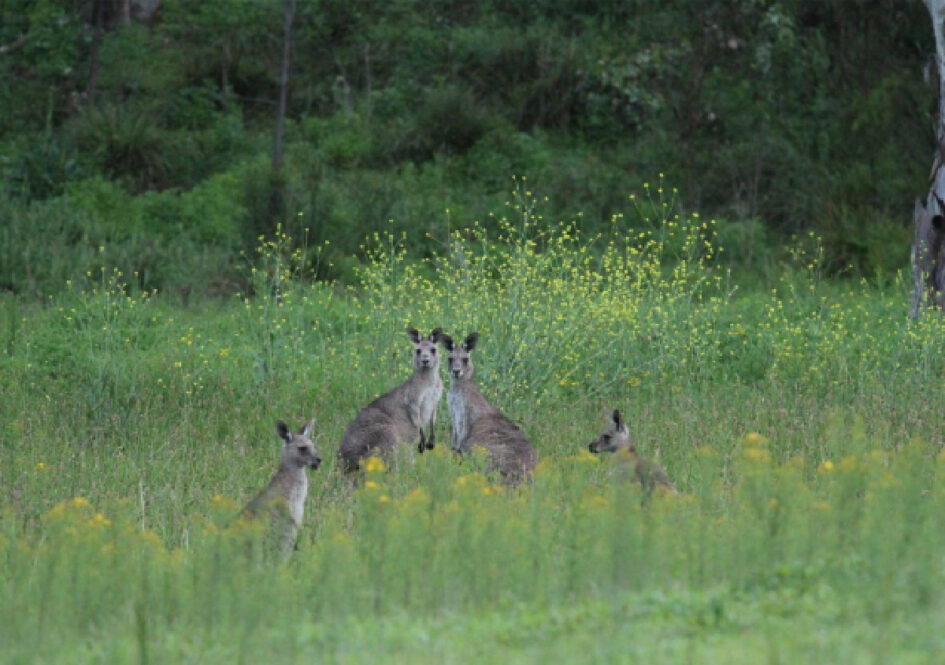By Lilly Matson: University of New South Wales
In a new study looking at animal behaviour, researchers analysed over 3000 photographs of a single kangaroo population.
Eastern grey kangaroos may develop and retain long-term relationships, contrary to previous beliefs about their social organisation, find researchers from UNSW Sydney.
“The eastern grey kangaroo is an iconic Australian marsupial, and perhaps our most well-recognised animal,” says Ms Nora Campbell, a PhD candidate from the School of Biological, Earth & Environmental Sciences (BEES). “They are an extremely social species, yet despite considerable research into kangaroo behaviour, key gaps remain in our understanding of their social organisation in the wild.”
There are often logistical difficulties in observing animal behaviours long term, but in this latest study, Ms Campbell and her supervisor Associate Professor Terry Ord were able to analyse over 3000 photographs of a single group of eastern grey kangaroos, taken over a period of six years.
By tracking which individuals had associated with each other across years, the team found the first evidence of possible long-term relationships among eastern grey kangaroos. Furthermore, by following the reproductive state of all females in the population, they discovered that females with joeys actively formed connections with other mothers, counter to what previous studies have suggested.
The study, published recently in the journal Animal Behaviour, provides new information on the sociality of this well-known animal, and could have implications for the management of kangaroos.
“Social organisation in animals is often underestimated and understanding it can help us better appreciate the intelligence and social complexity of non-humans,” says Ms Campbell.
An extensive photographic dataset
Eastern grey kangaroos have a social structure called fission-fusion, where they will form small groups that split and reform multiple times a day.
However, it has remained largely unknown whether kangaroos form long-term social bonds like other large herbivores, such as elephants and giraffes, and in particular, what factors might prompt individuals to associate or dissociate from one another.

The individual kangaroos within the group were identified by the unique shape of their ears. Photo: A/Prof. Terry Ord.
“One of the main difficulties in studying large herd animals like kangaroos is conducting studies over a long period of time, because you need a consistent population, that’s going to be there for an extended period,” says Ms Campbell.
However, Ms Campbell and A/Prof. Ord had six years’ worth of photographs of a single population of kangaroos at a private property near Mudgee, New South Wales. “We had about 3000 photographs of a population of kangaroos that we were able to analyse, which was a huge dataset.
“The photos were taken over one week in each year and because we could trace some of these kangaroos for six consecutive years, we set out to see how their sociality changed over this time period.”
Identifying kangaroos by their unique ear shape
A secondary challenge often faced by researchers carrying out large scale animal studies is that each individual needs to be identified.
In this case, just like humans’ distinct fingerprints, kangaroos can be identified by the unique shape of their ears.
“Obviously you have to be aware of the fact that they may get scars, or that ear shape will change very gradually over the years, but for the most part the shape of their ears is pretty consistent for each individual.”
Ms Campbell used a program called Contour – a tool originally developed to study the flukes in whale tails – to identify 130 kangaroos from the group.
“Once we had identified individual members, we went back and we had a look at the photos again, because we wanted to see which kangaroos were in the same photos together,” says Ms Campbell. “We worked out a baseline for how far apart the kangaroos had to be before you would consider them to be in the same group.
“We used a metric that measured the number of associations an individual has with another individual, and also the strength of these associations,” says Ms Campbell. “First we made a social network graph for each year of the survey, which showed the connections that each kangaroo had each year, then using that same metric, we calculated a social score for each kangaroo based on the social network graphs.”
Ms Campbell and A/Prof. Ord also looked at the extent those relationships varied with age, sex and reproductive state.
The team ended up focusing their observations on female-female relationships. “If we saw potential long-term relationships among females and juveniles, we discounted that and defined that as females with their own young. And then if we saw them with males and females, we said that was probably just mating habits.”
Complex social relationships between females
Analysis of the results suggests that kangaroo relationships could be far more complex than previously thought.
The social networks revealed through their statistical analysis showed some shifts in the social structure of the kangaroo population across the study years, namely a larger clustering in social networks in 2018 and 2019, and smaller, more modular clustering in 2015 and 2020.
Results found that 71 per cent of the group were members of at least one network and that the larger networks were centred on a few key individuals, most often adult females with young.
“Significantly, by tracking which individuals had associated with each other across years, we found the first evidence of possible long-term relationships among eastern grey kangaroos, which we noticed were particularly common among females,” says Ms Campbell.
“By recording the reproductive state of all females in the population, we found that those with young actively associated with other mothers, contrary to what past studies have indicated. This implies that the social structure of eastern grey kangaroos allows them to moderate their social position according to their reproductive state.”
Read more: UNSW Sydney evolutionary ecologist wins US Quest Award
Although it’s not fully understood why they observed this phenomenon, Ms Campbell says that the mothers may form relationships with other mothers to potentially dilute predation risk, harassment from males and aggression towards their young, or a combination of all these factors.
“We also think that females could be forming smaller groups when they have young, which matches previous findings, but then changing these groups more frequently, giving them a higher social score.”
Implications for kangaroo management
Despite being a symbol of Australia’s identity – the kangaroo is featured on the national coat of arms and is culturally important to many First Nation Australian communities – and despite grey kangaroos being a classic focus of research, there have remained significant gaps in what we know about kangaroo sociality and how it compares to other fission-fusion animals.
“I don’t think anybody had anticipated that they could potentially form long term friendships, because they seem to have such a loose, relaxed social structure,” says Ms Campbell.
“I suspect it’s possible that nobody had considered it. And honestly, we didn’t until we had these six years worth of data. And then we started to notice patterns. And we thought, wow, this is really interesting.”
These new insights into one of Australia’s iconic animals has potential implications for kangaroo management. “It’s important to understand the ways in which kangaroos relate to each other for management of kangaroo populations, because that’s going to then affect the breeding rate of the population and how widespread the groups are going to be.
“Kangaroos have adapted extremely well to urban environments, causing their numbers to rise to unsustainable levels in certain areas. This puts a lot of pressure on the environment while also negatively impacting the kangaroos themselves, especially during times of drought.”
Read more: The ‘brown food web’: dead vegetation plays essential role in desert ecosystems
Ms. Campbell is currently working on another study looking at the behavioral changes of the same group of kangaroos, related to rainfall and weather patterns.
“It’s always so exciting finding out a potential new theory about animal behaviour,” says Ms Campbell. “I would love to be able to carry out a larger study to look at long-term relationships and social trends in greater detail.”


